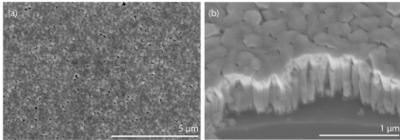Researchers at the Norwegian University of Science and Technology (NTNU) in Norway, Sophia University in Japan and SINTEF Industry, Norway have demonstrated the use of graphene as both a growth substrate and transparent conductive electrode for an ultraviolet light-emitting diode.
 Top- and bird-view SEM images of nanocolumns grown on DLG transferred onto amorphous silica glass
Top- and bird-view SEM images of nanocolumns grown on DLG transferred onto amorphous silica glass
The team focused on a flip-chip configuration, where GaN/AlGaN nanocolumns were grown as the light-emitting structure using plasma-assisted molecular beam epitaxy. Although the sheet resistance increased after nanocolumn growth compared with pristine double-layer graphene, the experiments showed that the double-layer graphene functioned adequately as an electrode. The GaN/AlGaN nanocolumns were found to exhibit a high crystal quality with no observable defects or stacking faults.
These results indicate that graphene can be used as a functional substrate and electrode for III-nitride-based device technology. Furthermore, this work indicated several possible steps for growth and device design optimization to improve the EQE now that this platform has been established.